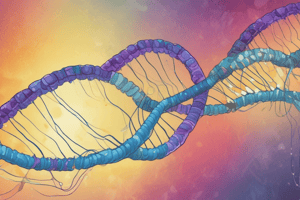Podcast
Questions and Answers
What is the effect of aberrant mRNA splicing on gene expression?
What is the effect of aberrant mRNA splicing on gene expression?
- It can lead to the production of dysfunctional proteins. (correct)
- It only affects non-coding RNAs.
- It has no impact on gene expression.
- It enhances gene expression significantly.
How is the translation of ferritin mRNA regulated?
How is the translation of ferritin mRNA regulated?
- By the expression levels of microRNAs only.
- By an increase in cellular temperature.
- Through the binding of ribosomes without any cofactors.
- By the presence of iron response element binding protein. (correct)
What role does nonsense-mediated decay play in mRNA quality control?
What role does nonsense-mediated decay play in mRNA quality control?
- It helps in the synthesis of miRNAs.
- It enhances the translation of defective mRNAs.
- It eliminates mRNAs that contain premature stop codons. (correct)
- It fosters the accumulation of faulty mRNAs.
What is the primary role of the mTOR pathway in cell growth?
What is the primary role of the mTOR pathway in cell growth?
How do miRNAs regulate mRNA stability and translation?
How do miRNAs regulate mRNA stability and translation?
What is the term used when a new amino acid is closely related in chemical properties to the original amino acid at a position in a protein?
What is the term used when a new amino acid is closely related in chemical properties to the original amino acid at a position in a protein?
Which of the following describes a nonsense mutation?
Which of the following describes a nonsense mutation?
What mechanism allows cells to prevent the translation of potentially toxic truncated proteins resulting from nonsense mutations?
What mechanism allows cells to prevent the translation of potentially toxic truncated proteins resulting from nonsense mutations?
Why is it difficult to predict the effects of missense mutations?
Why is it difficult to predict the effects of missense mutations?
Which type of amino acid substitution is least likely to disrupt protein function?
Which type of amino acid substitution is least likely to disrupt protein function?
What can be an outcome of a nonsense mutation in a gene?
What can be an outcome of a nonsense mutation in a gene?
Which codon is NOT considered a nonsense codon?
Which codon is NOT considered a nonsense codon?
What is a common feature of amino acids involved in conservative substitutions?
What is a common feature of amino acids involved in conservative substitutions?
What is the primary function of nonsense-mediated decay (NMD)?
What is the primary function of nonsense-mediated decay (NMD)?
What is a likely consequence of an insertion or deletion (INDEL) mutation that is not a multiple of three nucleotides?
What is a likely consequence of an insertion or deletion (INDEL) mutation that is not a multiple of three nucleotides?
Why are truncated proteins typically toxic to cells?
Why are truncated proteins typically toxic to cells?
What is the probability of encountering a stop codon in a new reading frame after an INDEL mutation?
What is the probability of encountering a stop codon in a new reading frame after an INDEL mutation?
Which of the following processes can lead to insertion and deletion (INDEL) mutations?
Which of the following processes can lead to insertion and deletion (INDEL) mutations?
What evolutionary mechanism helps maintain the integrity of open reading frames in protein-coding genes?
What evolutionary mechanism helps maintain the integrity of open reading frames in protein-coding genes?
Why do INDEL-generated premature stop codons rarely produce truncated proteins?
Why do INDEL-generated premature stop codons rarely produce truncated proteins?
What is the typical range of sizes for insertion or deletion (INDEL) mutations?
What is the typical range of sizes for insertion or deletion (INDEL) mutations?
What is the primary role of Dicer in the processing of miRNAs?
What is the primary role of Dicer in the processing of miRNAs?
How does the RNA-induced silencing complex (RISC) recognize its target mRNAs?
How does the RNA-induced silencing complex (RISC) recognize its target mRNAs?
What type of RNA degradation is referred to as Nonsense Mediated Decay (NMD)?
What type of RNA degradation is referred to as Nonsense Mediated Decay (NMD)?
What is the main function of the proteins that bind to mature miRNAs in the RISC complex?
What is the main function of the proteins that bind to mature miRNAs in the RISC complex?
Which component is responsible for exporting pre-miRNAs from the nucleus to the cytoplasm?
Which component is responsible for exporting pre-miRNAs from the nucleus to the cytoplasm?
What is the consequence of RISC binding to an mRNA target?
What is the consequence of RISC binding to an mRNA target?
What is typically the length of mature miRNAs processed from pre-miRNAs?
What is typically the length of mature miRNAs processed from pre-miRNAs?
How does the miRNA seed sequence relate to its target mRNA?
How does the miRNA seed sequence relate to its target mRNA?
Which process allows a single gene to produce multiple protein products by utilizing different splice sites?
Which process allows a single gene to produce multiple protein products by utilizing different splice sites?
What is a common mechanism that aids in the regulation of mRNA splicing?
What is a common mechanism that aids in the regulation of mRNA splicing?
Which of the following is not a strategy used by eukaryotic cells to produce multiple transcripts from a single gene?
Which of the following is not a strategy used by eukaryotic cells to produce multiple transcripts from a single gene?
Which component is involved in the nucleophilic attack at the 5’ splice junction during mRNA processing?
Which component is involved in the nucleophilic attack at the 5’ splice junction during mRNA processing?
What role do alternative polyadenylation sites play in mRNA processing?
What role do alternative polyadenylation sites play in mRNA processing?
Which of the following correctly describes the process of frame shifting?
Which of the following correctly describes the process of frame shifting?
What is the primary function of mRNA splicing in eukaryotic cells?
What is the primary function of mRNA splicing in eukaryotic cells?
Which option is part of the mRNA processing mechanism that does not directly involve splicing?
Which option is part of the mRNA processing mechanism that does not directly involve splicing?
Study Notes
Learning Objectives
- Understand the impact of alternative mRNA splicing on gene expression and its association with disease.
- Recognize how ferritin mRNA translation is influenced by iron response element binding proteins.
- Identify the significance of nonsense-mediated decay (NMD) in maintaining mRNA quality control.
- Comprehend the global control of translation by the mTOR pathway in various cellular contexts, including cancer.
- Describe the synthesis pathway of microRNAs (miRNAs) and their regulatory mechanisms on target mRNAs.
- Explain the mechanism of mRNA COVID-19 vaccines.
mRNA Splicing and Alternative Splicing
- Eukaryotic genes can generate multiple protein products via alternative RNA splice sites, polyadenylation sites, and translation start/stop codons.
- Post-translational cleavage of pro-peptides and ribosomal frame shifting contribute to protein diversity.
- Conservative substitutions: mutations that replace amino acids with chemically similar ones can maintain protein function.
- Non-conservative substitutions: different chemical properties can significantly alter protein function.
- Nonsense mutations create stop codons (UGA, UAA, UAG) that typically result in truncated proteins.
- Toxic truncated proteins may compete with wild-type proteins, leading to cellular dysfunction.
Nonsense-Mediated Decay (NMD)
- NMD is a cellular mechanism that identifies and degrades mRNAs with premature stop codons to prevent toxic protein synthesis.
- The process is crucial for avoiding dysfunctional proteins caused by mutations or improper splicing.
- NMD is vital for cellular quality control by managing aberrant transcripts.
Insertions and Deletions (INDELs)
- INDELs can result from replication errors or transposons, leading to shifts in the reading frame during translation.
- INDELs often generate premature stop codons, increasing the likelihood of producing toxic truncated proteins.
- Evolution has preserved open reading frames to minimize the impact of non-sense codons in exons.
MicroRNA (miRNA) Regulation
- miRNAs are synthesized as primary transcripts (pri-miRNAs), processed into pre-miRNAs, and exported to the cytoplasm.
- Dicer enzyme cleaves pre-miRNAs into mature miRNAs (21-22 nt) that form complexes with Argonaute proteins, creating the RNA-induced silencing complex (RISC).
- RISC identifies target mRNAs through complementarity, facilitating either translational repression or cleavage depending on binding characteristics.
mRNA Decay Mechanisms
- Both specific (NMD) and general pathways exist for RNA degradation, critically regulating gene expression levels.
- NMD specifically checks for nonsense codons in mRNAs to initiate degradation, safeguarding against faulty protein production.
Studying That Suits You
Use AI to generate personalized quizzes and flashcards to suit your learning preferences.
Related Documents
Description
Explore the complexities of mRNA splicing and its role in gene expression. This quiz covers alternative splicing, translation regulation, and the impact of mRNA decay mechanisms. Additionally, it examines how these processes are linked to diseases and the function of COVID-19 vaccines.




